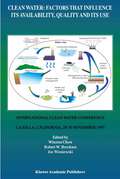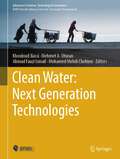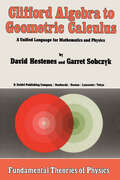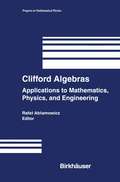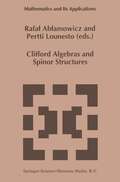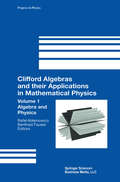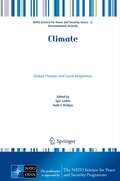- Table View
- List View
Clean-up of Former Soviet Military Installations: Identification and Selection of Environmental Technologies for Use in Central and Eastern Europe (Nato Science Partnership Subseries: 2 #1)
by Roy C. Herndon, John E. Moerlins, J. Michael Kuperberg, Peter I. Richter and Imre L. BiczόA NATO Advanced Research Workshop (ARW) was conducted on June 21-23, 1994 in Visegnid, Hungary related to the clean-up of former Soviet military installation sites. This ARW included a technical site visit to the Komarom Base Site which is a former Soviet military installation in Hungary. During this three-day ARW, a strategy and set of recommendations were developed for selecting technologies and evaluating remediation as the economic and approaches for these sites. This strategy incorporated such critical issues financial conditions of the region, temporal considerations with regard to the urgency for which remedial actions are needed for these sites, the prioritization of resource allocations for site clean-up using risk-based considerations, and other crucial issues which will affect the implementation of remedial activities in the region. Approximately 40 invited experts, representing a number of different disciplines as well as both NATO and Cooperation Partner countries from the region, participated in this ARW. The types of former Soviet military installations in Central and Eastern Europe include: aircraft bases, fueling areas, maintenance and repair facilities, training grounds, non ammunition storage areas (for lubricants, chemicals, paints, equipment), ammunition storage areas, medical facilities, production facilities, and municipal facilities. Environmental contamination at these sites poses significant human health and environmental risks. Site contaminants include: solvents (e. g. , BTEX), mineral oil hydrocarbons, polycyclic aromatic hydrocarbons (PAHs), chlorinated hydrocarbons, heavy metals, pesticides residues, and polychlorinated biphenyls (PCBs). The primary environmental media adversely affected by these contaminants are soils, ground water and surface water.
Clean Water: International Clean Water Conference held in La Jolla, California, 28–30 November 1995
by Winston Chow, Robert W. Brocksen and Joe WisniewskiACKNOWLEDGEMENTS IX PART I CONFERENCE SUMMARY STATEMENT R. W. BROCKSEN, W. CHOW, E. D. DAUGHERTY, Y. G. MUSSALLI, J. WISNIEWSKI and A. L. WOODIS I Clean Water: Factors that Influence its Availability, Quality and its Use: Summary of the International Water Conference 3-7 PART II WATER RESOURCE OVERVIEWS S. PECK I Managing and Protecting Our Water Resources 11-20 R. BROCKSEN, W. CHOW and K. CONNOR I Addressing Electric Utility Surface Water Challenges 21-29 C. LOHSE-HANSON I Lake Superior Binational Program: The Role of Electric Utilities 31-40 J. A. VEIL and D. O. MOSES I Consequences of Proposed Changes to Clean Water Act Thermal Discharges 41-52 PART III ECOLOGICAL I HEALTH RISKS c. SEIGNEUR, E. CONSTANTINOU and L. LEVIN I Multipathway Health Risk Assessment of Power Plant Water Discharges 55-64 C. W. CHEN, J. HERR, R. A. GOLDSTEIN, F. J. SAGONA, K. E. RYLANT and G. E. HAUSER I Watershed Risk Analysis Model for TVA's Holston River Basin 65-70 S. FERSON, L. R. GINZBURG and R. A. GOLDSTEIN I Inferring Ecological Risk from Toxicity Bioassays 71-82 C. ARQUIETT, M. GERKE and I. DATSKOU I Evaluation of Contaminated Groundwater Cleanup Objectives 83-92 G. L. BOWIE, J. G. SANDERS, G. F. RIEDEL, C. C. GILMOUR, D. L. BREITBURG, G. A. CUTIER and D. B. PORCELLA / Assessing Selenium Cycling and Accumulation in Aquatic Ecosystems 93-104 D. W. RODGERS, J. SCHRODER and L.
Clean Water: Next Generation Technologies (Advances in Science, Technology & Innovation)
by Khouloud Jlassi Mehmet A. Oturan Ahmad Fauzi Ismail Mohamed Mehdi ChehimiThis book summarises the recent, and future, sustainable, low-cost, environment-friendly and efficient systems for clean water production, to solve clean water crisis. We cover production of water the dew and rain or via desalination, Fenton processes or electrocoagulation; nanomaterial-based water purification methods including adsorption, catalysis, smart-sensors for pollutants detection and removal. We also cover environmental management, environmental policy aspects, and review recent patents and industrial processes to produce clean water. Written by experts in the domain of wastewater treatment, production of clean water and environmental management, this new book will be a unique tool for experts and students. We anticipate it open new horizons in clean water production and will be a source of inspiration for next generations of clean water technologies researchers
A Clear Flowing Yarra
by Harry SaddlerThey say you can't step in the same river twice, and it's true that the Yarra has been hugely changed - but this book is a glorious and timely reminder that things can also be changed for the better.Nature writer Harry Saddler hops, skips and jumps his way along, beside, on and even in the Yarra River from source to mouth, reveling in its hidden beauty, getting close to platypuses, kingfishers, Krefft's gliders and the occasional seal, and meeting many of the swimmers, bushwalkers, ecologists and traditional owners who are quietly and tenaciously restoring the river, patch by patch.Optimistic, inspiring and heartfelt, A Clear Flowing Yarra is a passionate love letter to the river that shapes Melbourne, and an evocative vision of what it is now and what it can be.
Clearing the Air: The Beginning and the End of Air Pollution
by Tim Smedley'Read this book and join the effort to terminate air pollution.' Arnold SchwarzeneggerAir pollution has become the world's greatest environmental health risk, and science is only beginning to reveal its wide-ranging effects. Globally, 19,000 people die each day from air pollution, killing more than HIV/AIDS, tuberculosis, malaria and car accidents combined.What happened to the air we breathe?Sustainability journalist Tim Smedley has travelled the world to try and find the answer, visiting cities at the forefront of the fight against air pollution, including Delhi, Beijing, London and Paris. With insights from the scientists and politicians leading the battle against it, and people whose lives have been affected by it,Clearing the Air tells the full story of air pollution for the first time: what it is, which pollutants are harmful, where they come from and – most importantly – what we can do about them.Air pollution is a problem that can be solved. The stories uncovered on this journey show us how.Clearing the Air is essential reading for anyone who cares about the air they breathe. And this much becomes clear: in the fight against air pollution, we all have a part to play. The fightback has begun.'Compulsory reading' Chris Boardman
Cliff Collapse (large print)
by RnibThis page shows two images of a sea cliff, a plan view at the top and a front view at the bottom of the page. There is a locator dot shown, which will be at the top left, when the image is the correct way up. Each image is surrounded by an image border. The image in the top of the page shows the top of a cliff at the top and sea at the bottom and right of the image. In the centre is a mass of cliff that has slumped down and out into the sea. The image in the bottom of the page shows the face of the cliff and sea at the bottom of the image. In the centre bottom the mass of cliff that has slumped down and out into the sea. It still has a patch of grass on it from the cliff top.
Cliff Collapse (UEB contracted)
by RnibThis page shows two images of a sea cliff, a plan view at the top and a front view at the bottom of the page. There is a locator dot shown, which will be at the top left, when the image is the correct way up. Each image is surrounded by an image border. The image in the top of the page shows the top of a cliff at the top and sea at the bottom and right of the image. In the centre is a mass of cliff that has slumped down and out into the sea. The image in the bottom of the page shows the face of the cliff and sea at the bottom of the image. In the centre bottom the mass of cliff that has slumped down and out into the sea. It still has a patch of grass on it from the cliff top.
Cliff Collapse (UEB uncontracted)
by RnibThis page shows two images of a sea cliff, a plan view at the top and a front view at the bottom of the page. There is a locator dot shown, which will be at the top left, when the image is the correct way up. Each image is surrounded by an image border. The image in the top of the page shows the top of a cliff at the top and sea at the bottom and right of the image. In the centre is a mass of cliff that has slumped down and out into the sea. The image in the bottom of the page shows the face of the cliff and sea at the bottom of the image. In the centre bottom the mass of cliff that has slumped down and out into the sea. It still has a patch of grass on it from the cliff top.
Cliff Erosion at Southerndown, South Wales (tactile)
by RnibThis is a tactile diagram for GCSE level students. The diagram consists of two pages: a key, and a map showing the cliff erosion. The key includes textures for the sea, and types of earth, as well as some included landmarks and features. The map shows a section of coastline, with the sea as a texture. Layers of different texture indicate soil types, and arrows at the right and bottom describe the differing coastline.
Clifford Algebra and Spinor-Valued Functions: A Function Theory for the Dirac Operator (Mathematics and Its Applications #53)
by R. Delanghe F. Sommen V. SoucekClifford Algebra to Geometric Calculus: A Unified Language for Mathematics and Physics (Fundamental Theories of Physics #5)
by D. Hestenes Garret SobczykMatrix algebra has been called "the arithmetic of higher mathematics" [Be]. We think the basis for a better arithmetic has long been available, but its versatility has hardly been appreciated, and it has not yet been integrated into the mainstream of mathematics. We refer to the system commonly called 'Clifford Algebra', though we prefer the name 'Geometric Algebm' suggested by Clifford himself. Many distinct algebraic systems have been adapted or developed to express geometric relations and describe geometric structures. Especially notable are those algebras which have been used for this purpose in physics, in particular, the system of complex numbers, the quatemions, matrix algebra, vector, tensor and spinor algebras and the algebra of differential forms. Each of these geometric algebras has some significant advantage over the others in certain applications, so no one of them provides an adequate algebraic structure for all purposes of geometry and physics. At the same time, the algebras overlap considerably, so they provide several different mathematical representations for individual geometrical or physical ideas.
Clifford Algebras: Applications to Mathematics, Physics, and Engineering (Progress in Mathematical Physics #34)
by Rafal AblamowiczThe invited papers in this volume provide a detailed examination of Clifford algebras and their significance to analysis, geometry, mathematical structures, physics, and applications in engineering. While the papers collected in this volume require that the reader possess a solid knowledge of appropriate background material, they lead to the most current research topics. With its wide range of topics, well-established contributors, and excellent references and index, this book will appeal to graduate students and researchers.
Clifford Algebras and Lie Theory
by Eckhard MeinrenkenThis monograph provides an introduction to the theory of Clifford algebras, with an emphasis on its connections with the theory of Lie groups and Lie algebras. The book starts with a detailed presentation of the main results on symmetric bilinear forms and Clifford algebras. It develops the spin groups and the spin representation, culminating in Cartan’s famous triality automorphism for the group Spin(8). The discussion of enveloping algebras includes a presentation of Petracci’s proof of the Poincaré–Birkhoff–Witt theorem.This is followed by discussions of Weil algebras, Chern--Weil theory, the quantum Weil algebra, and the cubic Dirac operator. The applications to Lie theory include Duflo’s theorem for the case of quadratic Lie algebras, multiplets of representations, and Dirac induction. The last part of the book is an account of Kostant’s structure theory of the Clifford algebra over a semisimple Lie algebra. It describes his “Clifford algebra analogue” of the Hopf–Koszul–Samelson theorem, and explains his fascinating conjecture relating the Harish-Chandra projection for Clifford algebras to the principal sl(2) subalgebra.Aside from these beautiful applications, the book will serve as a convenient and up-to-date reference for background material from Clifford theory, relevant for students and researchers in mathematics and physics.
Clifford Algebras and Spinor Structures: A Special Volume Dedicated to the Memory of Albert Crumeyrolle (1919–1992) (Mathematics and Its Applications #321)
by Rafal Ablamowicz P. LounestoThis volume is dedicated to the memory of Albert Crumeyrolle, who died on June 17, 1992. In organizing the volume we gave priority to: articles summarizing Crumeyrolle's own work in differential geometry, general relativity and spinors, articles which give the reader an idea of the depth and breadth of Crumeyrolle's research interests and influence in the field, articles of high scientific quality which would be of general interest. In each of the areas to which Crumeyrolle made significant contribution - Clifford and exterior algebras, Weyl and pure spinors, spin structures on manifolds, principle of triality, conformal geometry - there has been substantial progress. Our hope is that the volume conveys the originality of Crumeyrolle's own work, the continuing vitality of the field he influenced, and the enduring respect for, and tribute to, him and his accomplishments in the mathematical community. It isour pleasure to thank Peter Morgan, Artibano Micali, Joseph Grifone, Marie Crumeyrolle and Kluwer Academic Publishers for their help in preparingthis volume.
Clifford Algebras and their Applications in Mathematical Physics: Volume 1: Algebra and Physics (Progress in Mathematical Physics #18)
by Rafal Ablamowicz Bertfried FauserThe plausible relativistic physical variables describing a spinning, charged and massive particle are, besides the charge itself, its Minkowski (four) po sition X, its relativistic linear (four) momentum P and also its so-called Lorentz (four) angular momentum E # 0, the latter forming four trans lation invariant part of its total angular (four) momentum M. Expressing these variables in terms of Poincare covariant real valued functions defined on an extended relativistic phase space [2, 7J means that the mutual Pois son bracket relations among the total angular momentum functions Mab and the linear momentum functions pa have to represent the commutation relations of the Poincare algebra. On any such an extended relativistic phase space, as shown by Zakrzewski [2, 7], the (natural?) Poisson bracket relations (1. 1) imply that for the splitting of the total angular momentum into its orbital and its spin part (1. 2) one necessarily obtains (1. 3) On the other hand it is always possible to shift (translate) the commuting (see (1. 1)) four position xa by a four vector ~Xa (1. 4) so that the total angular four momentum splits instead into a new orbital and a new (Pauli-Lubanski) spin part (1. 5) in such a way that (1. 6) However, as proved by Zakrzewski [2, 7J, the so-defined new shifted four a position functions X must fulfill the following Poisson bracket relations: (1.
Clifford Algebras and their Applications in Mathematical Physics: Proceedings of the Third Conference held at Deinze, Belgium, 1993 (Fundamental Theories of Physics #55)
by F. Brackx R. Delanghe H. SerrasThis International Conference on Clifford AlgebrfU and Their Application, in Math ematical Phy,ic, is the third in a series of conferences on this theme, which started at the Univer,ity of Kent in Canterbury in 1985 and was continued at the Univer,iU de, Science, et Technique, du Languedoc in Montpellier in 1989. Since the start of this series of Conferences the research fields under consideration have evolved quite a lot. The number of scientific papers on Clifford Algebra, Clifford Analysis and their impact on the modelling of physics phenomena have increased tremendously and several new books on these topics were published. We were very pleased to see old friends back and to wellcome new guests who by their inspiring talks contributed fundamentally to tracing new paths for the future development of this research area. The Conference was organized in Deinze, a small rural town in the vicinity of the University town Gent. It was hosted by De Ceder, a vacation and seminar center in a green area, a typical landscape of Flanders's "plat pays" . The Conference was attended by 61 participants coming from 18 countries; there were 10 main talks on invitation, 37 contributions accepted by the Organizing Com mittee and a poster session. There was also a book display of Kluwer Academic Publishers. As in the Proceedings of the Canterbury and Montpellier conferences we have grouped the papers accordingly to the themes they are related to: Clifford Algebra, Clifford Analysis, Classical Mechanics, Mathematical Physics and Physics Models.
Clifford Algebras and their Applications in Mathematical Physics: Volume 2: Clifford Analysis (pdf) (Progress in Mathematical Physics #19)
by John Ryan Wolfgang SprößigClifford Algebras in Analysis and Related Topics (Studies in Advanced Mathematics #21)
by John RyanThis new book contains the most up-to-date and focused description of the applications of Clifford algebras in analysis, particularly classical harmonic analysis. It is the first single volume devoted to applications of Clifford analysis to other aspects of analysis.All chapters are written by world authorities in the area. Of particular interest is the contribution of Professor Alan McIntosh. He gives a detailed account of the links between Clifford algebras, monogenic and harmonic functions and the correspondence between monogenic functions and holomorphic functions of several complex variables under Fourier transforms. He describes the correspondence between algebras of singular integrals on Lipschitz surfaces and functional calculi of Dirac operators on these surfaces. He also discusses links with boundary value problems over Lipschitz domains.Other specific topics include Hardy spaces and compensated compactness in Euclidean space; applications to acoustic scattering and Galerkin estimates; scattering theory for orthogonal wavelets; applications of the conformal group and Vahalen matrices; Newmann type problems for the Dirac operator; plus much, much more!Clifford Algebras in Analysis and Related Topics also contains the most comprehensive section on open problems available. The book presents the most detailed link between Clifford analysis and classical harmonic analysis. It is a refreshing break from the many expensive and lengthy volumes currently found on the subject.
Clifford Algebras in Analysis and Related Topics (Studies in Advanced Mathematics #21)
by John RyanThis new book contains the most up-to-date and focused description of the applications of Clifford algebras in analysis, particularly classical harmonic analysis. It is the first single volume devoted to applications of Clifford analysis to other aspects of analysis.All chapters are written by world authorities in the area. Of particular interest is the contribution of Professor Alan McIntosh. He gives a detailed account of the links between Clifford algebras, monogenic and harmonic functions and the correspondence between monogenic functions and holomorphic functions of several complex variables under Fourier transforms. He describes the correspondence between algebras of singular integrals on Lipschitz surfaces and functional calculi of Dirac operators on these surfaces. He also discusses links with boundary value problems over Lipschitz domains.Other specific topics include Hardy spaces and compensated compactness in Euclidean space; applications to acoustic scattering and Galerkin estimates; scattering theory for orthogonal wavelets; applications of the conformal group and Vahalen matrices; Newmann type problems for the Dirac operator; plus much, much more!Clifford Algebras in Analysis and Related Topics also contains the most comprehensive section on open problems available. The book presents the most detailed link between Clifford analysis and classical harmonic analysis. It is a refreshing break from the many expensive and lengthy volumes currently found on the subject.
Clifford (Geometric) Algebras: with applications to physics, mathematics, and engineering
by William E. BaylisThis volume is an outgrowth of the 1995 Summer School on Theoretical Physics of the Canadian Association of Physicists (CAP), held in Banff, Alberta, in the Canadian Rockies, from July 30 to August 12,1995. The chapters, based on lectures given at the School, are designed to be tutorial in nature, and many include exercises to assist the learning process. Most lecturers gave three or four fifty-minute lectures aimed at relative novices in the field. More emphasis is therefore placed on pedagogy and establishing comprehension than on erudition and superior scholarship. Of course, new and exciting results are presented in applications of Clifford algebras, but in a coherent and user-friendly way to the nonspecialist. The subject area of the volume is Clifford algebra and its applications. Through the geometric language of the Clifford-algebra approach, many concepts in physics are clarified, united, and extended in new and sometimes surprising directions. In particular, the approach eliminates the formal gaps that traditionally separate clas sical, quantum, and relativistic physics. It thereby makes the study of physics more efficient and the research more penetrating, and it suggests resolutions to a major physics problem of the twentieth century, namely how to unite quantum theory and gravity. The term "geometric algebra" was used by Clifford himself, and David Hestenes has suggested its use in order to emphasize its wide applicability, and b& cause the developments by Clifford were themselves based heavily on previous work by Grassmann, Hamilton, Rodrigues, Gauss, and others.
Clifford Numbers and Spinors (Fundamental Theories of Physics #54)
by Marcel RieszMarcellliesz's lectures delivered on October 1957 -January 1958 at the Uni versity of Maryland, College Park, have been previously published only infor mally as a manuscript entitled CLIFFORD NUMBERS AND SPINORS (Chap ters I - IV). As the title says, the lecture notes consist of four Chapters I, II, III and IV. However, in the preface of the lecture notes lliesz refers to Chapters V and VI which he could not finish. Chapter VI is mentioned on pages 1, 3, 16, 38 and 156, which makes it plausible that lliesz was well aware of what he was going to include in the final missing chapters. The present book makes lliesz's classic lecture notes generally available to a wider audience and tries somewhat to fill in one of the last missing chapters. This book also tries to evaluate lliesz's influence on the present research on Clifford algebras and draws special attention to lliesz's contributions in this field - often misunderstood.
Climate: Global Change and Local Adaptation (NATO Science for Peace and Security Series C: Environmental Security)
by Igor Linkov and Todd S. BridgesRising sea levels and altered weather patterns are expected to significantly alter coastal and inland environments for humans, infrastructure and ecosystems. Potential land-use changes and population increases, coupled with uncertain predictions for sea level rise and storm frequency/intensity represent a significant planning challenge. While efforts to mitigate climate change continue, plans must be made to adapt to the risks that climate change poses to humans, infrastructure, and ecosystems alike. This book addresses integrated environmental assessment and management as part of the nexus of climate change adaptation. Risk analysis has emerged as a useful approach to guide assessment, communication and management of security risks. However, with respect to climate change, an integrated, multi-criteria, multi-hazard, risk-informed decision framework is desirable for evaluating adaptation strategies. The papers in Part 1 summarize societal and political needs for climate change adaptation. Part 2 includes papers summarizing the state of the art in climate change adaptation. Three further parts cover: the process of change in coastal regions, in inland regions, and, finally, the potential challenges to homeland security for national governments. Each of these parts reviews achievements, identifies gaps in current knowledge, and suggests research priorities.
Climate: Past, Present and Future (Routledge Revivals: A History Of Climate Changes Ser.)
by H. H. Lamb"First Published in 1972, Routledge is an imprint of Taylor & Francis, an informa company."
Climate: Past, Present and Future
by H. H. Lamb"First Published in 1972, Routledge is an imprint of Taylor & Francis, an informa company."
Climate Action: The Future Is In Our Hands
by Katie Rewse Georgina StevensThis book is about changing the world for the better. It’s about how we all have the power to make a real difference. And it’s also about the many incredible young people, just like you, who are already taking action at a time when change is most needed. This is a book about climate change, and the actions we can take in preventing it. From its causes and the effects they have on our beautiful planet, to the changes we can make, young eco enthusiasts will love finding out more about this global crisis. With vibrant artwork from Katie Rewse and engaging text from Georgina Stevens, Climate Action is a positive guide to the changes, both big and small, we can make. From sustainable shopping to pollution-tackling green roofs, there are so many exciting innovations which are helping us in our quest to save the planet. What’s more, profiles about the young change-makers making waves to save our planet encourage young learners to join the environmental movement. Inspiring, informative and uplifting, this is the perfect handbook for being the change we want to see. Now featuring updated facts and statistics to reflect environmental changes that have taken place since the publication of the hardback edition.

